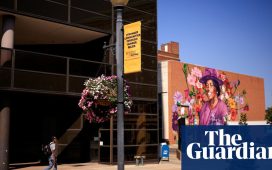The Biden administration has quietly tasked six humanitarian groups with recommending which migrants should be allowed to stay in the US, instead of being rapidly expelled from the country under federal pandemic-related powers that block people from seeking asylum.
The groups will determine who is most vulnerable, on the Mexican side of the border, and their criteria has not been made public.
The move comes as large numbers of people are crossing the southern border and as the government faces intensifying pressure to lift the public health powers instituted by the former president Donald Trump and kept in place by Joe Biden during the coronavirus pandemic.
Several members of the consortium spoke to the Associated Press about the criteria and provided details of the system that have not been previously reported.
The government is aiming to admit to the country up to 250 asylum seekers a day who are referred by the groups and is agreeing to that system only until 31 July.
By then, the consortium hopes the Biden administration will have lifted the public health rules, though the government has not committed to that.
So far, a total of nearly 800 asylum seekers have been let in since 3 May, and members of the consortium say there is already more demand than they can meet.
The groups have not been publicly identified except for the International Rescue Committee, a global relief organization.
The others are London-based Save the Children; two US-based organizations, HIAS and Kids in Need of Defense; and two Mexico-based organizations, Asylum Access and the Institute for Women in Migration, according to two people with direct knowledge, who spoke on condition of anonymity because the information was not intended for public release.
Asylum Access, which provides services to people seeing asylum in Mexico, characterized its role as minimal.
The effort started in El Paso, Texas, and is expanding to Nogales, Arizona.
A similar but separate mechanism led by the American Civil Liberties Union began in late March and allows 35 families a day into the United States at places along the border. It has no end date.
The twin tracks are described by participating organizations as an imperfect transition from so-called Title 42 authority, named for a section of an obscure 1944 public health law that Trump used in March 2020 to effectively end asylum entries at the Mexican border.
With Covid-19 vaccination rates rising, Biden is finding it increasingly difficult to justify the expulsions on public health grounds and faces demands to end it from the United Nations refugee agency and members of his own party and administration.
Critics of the new selection processes say too much power is vested in a small number of organizations and that the effort is shrouded in secrecy without a clear explanation of how the groups were chosen.
Critics also say there are no assurances that the most vulnerable or deserving migrants will be chosen to seek asylum.
Some consortium members are concerned that going public may cause their offices in Mexico to be mobbed by asylum seekers, overwhelming their tiny staffs and exposing them to potential threats and physical attacks from extortionists and other criminals.
The consortium was formed after the US government asked the UN high commissioner for refugees’ office in Mexico for the names of organizations with deep experience and capacity in Mexico, said Sibylla Brodzinsky, a spokeswoman for the UN office.
“We’ve had long relationships with them and they’re trusted partners,” she said.
The groups say they are merely streamlining the process but that the vulnerable migrants’ cases can come from anywhere.
In Nogales, Arizona, the International Rescue Committee is connecting to migrants via social media and smartphones to find candidates.
It plans to refer up to 600 people a month to US officials, said Raymundo Tamayo, the group’s director in Mexico.
Special consideration is being given to people who have been waiting in Mexico a long time, are in need of acute medical attention or who have disabilities, are members of the LGBTQ+ community or are non-Spanish speakers, though each case is being weighed on its unique circumstances, Tamayo said.
ACLU attorney Lee Gelernt said advocacy groups are in “a very difficult position because they need to essentially rank the desperation” of people, but he insisted it was temporary. The government, he said, “cannot farm out the asylum system”.
Migration experts not involved in the process have questioned how the groups determine who is eligible.
“It has been murky,” said Jessica Bolter, an analyst at the non-partisan Migration Policy Institute who believes the administration is trying to quietly be humane without encouraging more people to come, a balancing act she doubts will succeed.
“Setting out clear and accurate information about how and who might get in might lead to fewer migrants making the trip, so there’s not this game of chance that kind of seems to be in place right now,” Bolter said.
US border authorities recorded the highest number of encounters with migrants in more than 20 years in April, though many were those who have crossed the border repeatedly in an attempt to gain legal entry to the US and who had previously been expelled from the country.








